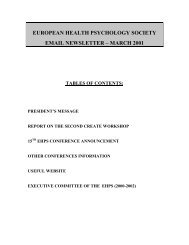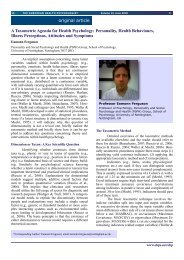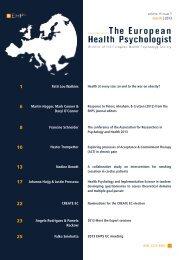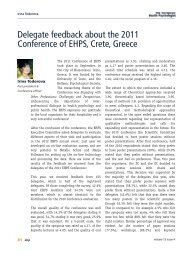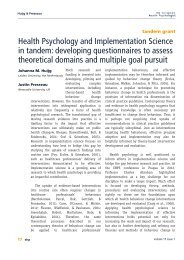PDF download entire issue - European Health Psychology Society
PDF download entire issue - European Health Psychology Society
PDF download entire issue - European Health Psychology Society
Create successful ePaper yourself
Turn your PDF publications into a flip-book with our unique Google optimized e-Paper software.
Yarkoni<br />
opinion piece<br />
Functional MRI in <strong>Health</strong> <strong>Psychology</strong> and<br />
beyond: A call for caution<br />
Tal Yarkoni<br />
Functional magnetic resonance<br />
imaging (fMRI) has<br />
University of Colorado at<br />
emerged as a primary tool in<br />
Boulder<br />
psychologists’ arsenal. The<br />
ability to peer inside the waking brain as it<br />
produces language, perceives visual objects, and<br />
interacts with the social world has provided<br />
unprecedented opportunities to investigate and<br />
understand the neural architecture of human<br />
cognition. But as Spider-Man’s uncle, Ben Parker,<br />
once famously said: with great power comes<br />
great responsibility. Because of the high cost of<br />
fMRI data collection, the opportunity cost of a<br />
poorly conducted fMRI study is liable to be much<br />
greater than that of the typical behavioral study.<br />
And because of the unusually strong influence<br />
brain images wield over the popular imagination<br />
(McCabe & Castel, 2008), it may be easier to<br />
convince the public, other scientists, and even<br />
one’s self, of conclusions that are not wholly<br />
supported by the data.<br />
In this short opinion piece, I lay out several<br />
reasons for exercising caution when conducting<br />
fMRI studies. Although the piece is intended for<br />
a health psychology audience, one of the points<br />
I hope to convey is that the challenges that face<br />
health psychologists using fMRI are very much<br />
the same ones that face other psychologists. So<br />
while the examples I’ll use may have particular<br />
relevance to health psychologists, they should<br />
also illustrate much more general principles that<br />
apply to many, if not most, fMRI studies. This is<br />
by no means a comprehensive overview of the<br />
methodological and conceptual challenges<br />
involved in designing, analyzing, and reporting<br />
fMRI studies; I simply highlight a few <strong>issue</strong>s that<br />
pose serious threats to the conclusions of many<br />
fMRI studies, and remain, in my view, widely<br />
underappreciated.<br />
The vagaries of low power<br />
When running an experimental study, it is<br />
desirable to ensure that the study is adequately<br />
powered; that is, if the targeted effect really<br />
exists in the population, the study will detect it<br />
with high probability. In practice, however,<br />
studies in most branches of psychology tend to<br />
be underpowered (Cohen, 1992), and fMRI<br />
studies appear to be particularly so (Yarkoni,<br />
2009; Yarkoni & Braver, 2010). Because fMRI<br />
data acquisition is extremely expensive<br />
(typically several hundred dollars per hour),<br />
there’s a strong pressure to collect as little data<br />
as possible. In practice, the modal fMRI sample<br />
size of 15 – 20 subjects often provides little<br />
power to detect anything but very large effects<br />
(Yarkoni, 2009). For example, a one-sample t-<br />
test performed on 20 subjects at a statistical<br />
threshold of p < .001 (the modal threshold in<br />
the fMRI literature) has only 40% power to<br />
detect even a canonically ‘large’ effect of d = 0.8.<br />
For a correlational analysis, the same sample size<br />
provides only 12% power to detect an extremely<br />
large correlation of r = 0.5. And yet simulations<br />
suggest that even a seemingly stringent (by<br />
behavioral psychology standards) threshold of<br />
p < .001 is insufficient to adequately control for<br />
false positives (Wager, Lindquist, & Kaplan,<br />
2007). The inevitable conclusion is that the<br />
modal whole-brain fMRI analysis detects only a<br />
small minority of true effects while producing a<br />
high rate of false positives.<br />
61 ehp volume 13 <strong>issue</strong> 4



